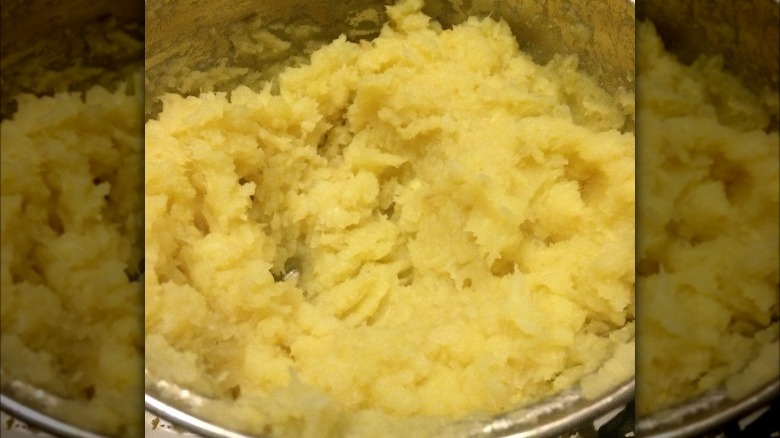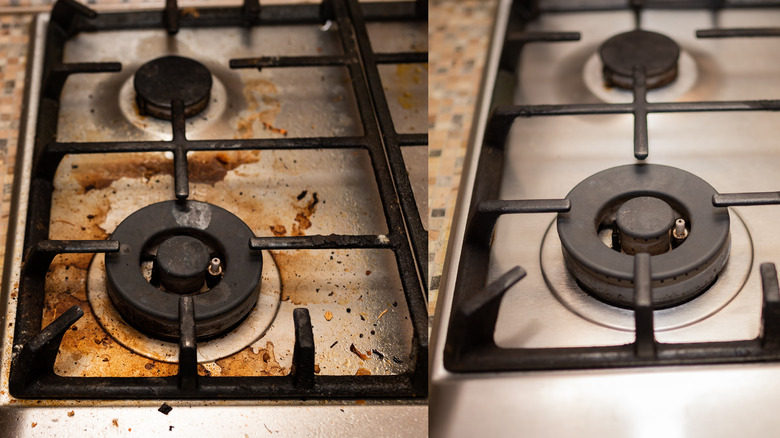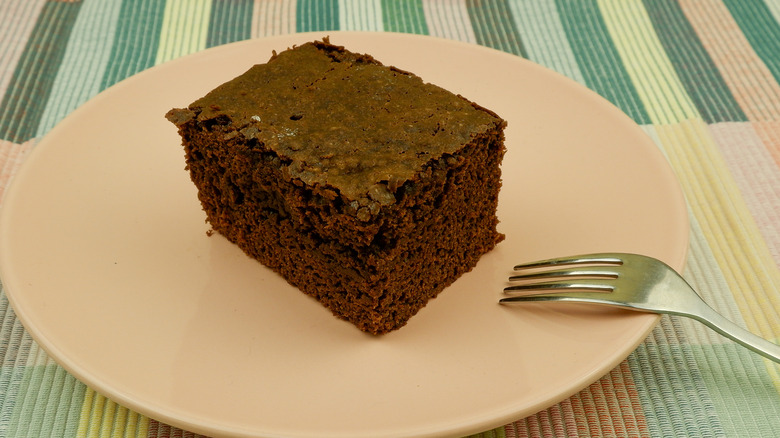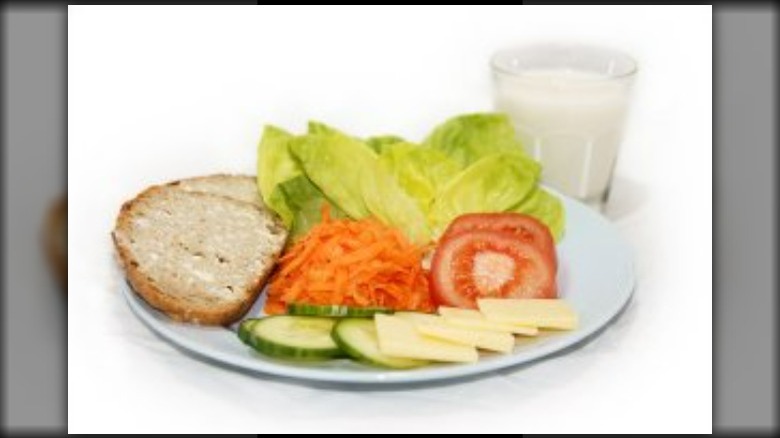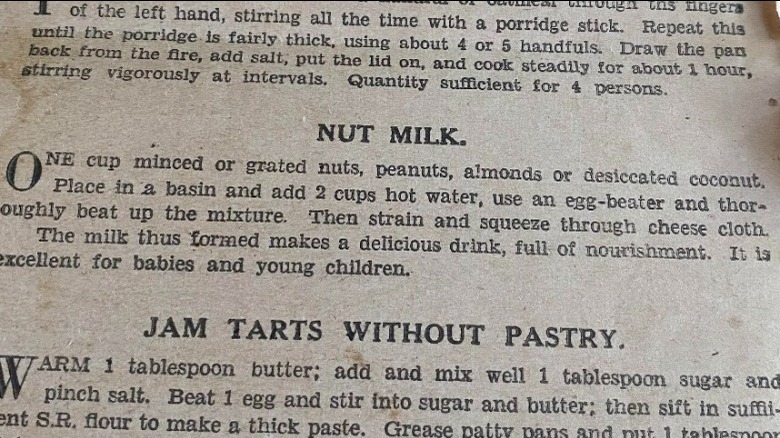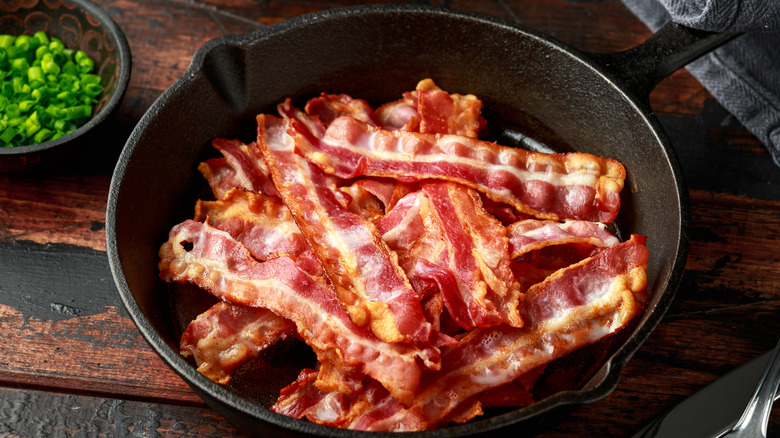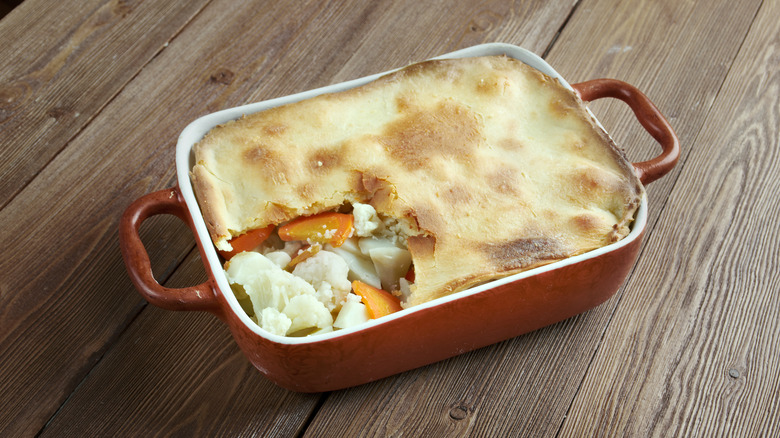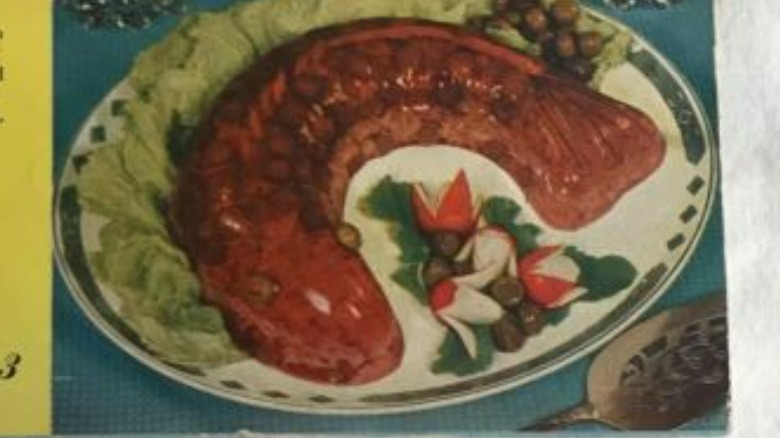Foods From The 1940s That Should Never Come Back
The 1940s was admittedly not the brightest of decades we remember when we open our history books. It was the decade in which the world was thrown into World War II, with the stench of fear and worry looming over the heads of people all over the globe. Even though the dark war lasted half the decade, the effects of the event were felt well after the war ended, and still impact people to this day, in ways that we might not even be aware of at first. You may not remember anything yourself, though you may have fond memories of pulling up a stool and listening to a parent or relative talk about their various experiences during the '40s.
One important, yet often overlooked aspect of this period was the interesting recipes that were concocted due to the restrictions and shortages that many had to deal with at this time. While many of the crucial dishes and drinks that came out of this decade are still enjoyed by many to this day, others were not enjoyed as much and are more infamous than fondly remembered. There are some dishes that we hope to see come back and be served more commonly in our households. However, there are other platters that we don't wish to see surface, so here are some foods from the 1940s that we think should never come back.
Mock Banana
Britain was hit roughly by the war, and lots of the foods that they enjoyed were not as readily available as they used to be — and that includes bananas. According to AtlasObscura, in November of 1940, Lord Woolton, the Minister of Food at the time, enforced a ban on banana imports, which was upsetting to people all over the country. It was so upsetting, that Harry Roy, a British singer and dancer, even made a song, asking when he'd be able to have a banana again. To cope with this loss, attempts were made to make banana-like substances to go on sandwiches and make up for the tropical fruit shortage.
The mock banana sandwich, as expected, has no banana in it. It's made out of caster sugar, banana essence, and LOTS of parsnip (via TheDailyMeal). What you get does slightly resemble the taste of banana, and we can see why these worked during WWII, however, there is the heavy taste of parsnips, and even if you like the vegetable, why go through the trouble of making a parsnip sandwich when you want to have something with bananas? Luckily, we're able to run to the nearest store, pick out a batch of the yellow fruits, and use them in sandwiches, cakes, and smoothies, so why replace what's already delicious?
Wartime Drippings
If you've ever cooked, fried, or baked a serving of bacon or meat, then you know the large amounts of grease and fat that come off of the delicious delicacies. For some people, this is what adds a bit of substance to the meat, but for others, they prefer to get rid of all the grease, and make their meat a bit less fatty, soggy and drippy. Back in the 1940's, this "dripping" had another use, and was requested from citizens by the government to make explosives. When families weren't collecting it to give away for the war effort, they were using the fat for cooking purposes.
Families would keep and store the drippings left over by cooking meats, and use them as a spread for breads, or use it on vegetables (via Cookist). While certain fatty foods can be delicious, drippings aren't necessarily something we want brought back. They were used like butter according to wartime ads (as per Newspapers.com), but when we actually have butter, and far more delicious butter substitutes, why settle for something that you don't have to? Drippings came out of a period of scarcity, and since we are fortunate enough to find loads of different butters at our local grocery stores, it's likely tastier, and far less work to just buy a stick of that instead.
Wartime Cake
Like most foods and items during WWII, butter and sugar were also rationed heavily by the government, and the recipes that called for copious amounts of what was considered limited resources at the time were unable to be cooked or baked as frequently. Due to this, cakes, chocolate, and sweet creams weren't as commonplace as they would be before and after World War II, as well. Makeshift sweets that didn't use as much sugar in their making became the new norm for people who wanted to get the most out of their meals while living under the difficult food restrictions of the time. This led to newspapers being filled with recipes for cakes that called for fewer ingredients and were possible with the constraints everyone was facing (via AtlasObscura).
Low butter and sugar recipe cakes such as the "Victory Cake" or a "Wacky Cake" became popular due to the ease it took to make them, and — in the case of the Wacky Cake especially — didn't require eggs, butter, or milk (as per QuaintCooking). This definitely works for anyone with restrictive diets, or those who are running low on the key ingredients for a cake, but in this day and age, you can buy pastries from bakeries all over the country, or get some boxed cake mix, along with all of the other ingredients at the grocery store.
The Oslo Meal
Though they may not be the healthiest thing to bring to school for lunch, there's something special about a kid opening up their lunch box, and getting excited upon seeing a pack of Lunchables inside. Though they aren't as healthy as a salad, Lunchables are far from the worst thing to have for lunch, and if you or your kids enjoy them, there's no harm in having them from time to time. They're delicious too, and can range from a make-your-own pizza set, to cheese, ham, and crackers. Obviously, Lunchables didn't exist in the '40s, but there was a school lunch experiment called "The Oslo Meal" that somewhat resembled a knock-off Lunchable.
The Oslo meal was a free, uncooked meal offered by schools to their students, which typically included lots of vegetables, like carrots, lettuce, and other veggies you might find in a salad, two slices of bread, and some cheese blocks (Via JSTOR). This is certainly a much healthier meal than what you might find in many school cafeterias today, and they could be put together to make a sandwich, but the lack of meat or anything really "fun" wouldn't make for the most enjoyable school lunch for most kids. Although this might work for an adult at work, if your kid is used to them, you might want to stick to the Lunchables.
Mock Foods
There are several recipes on this list that are "mock" versions of certain foods that weren't as readily available as they used to be. Foods such as cheese, meats, and even staple drinks like coffee had to be rationed to help in keeping the war effort going (via NationalWW2Museum). Luxuries that many take for granted, like meats, sweets, and even certain fruits were not as easy to get as they are at the moment, leading many families to create "mock" dishes and replacements for the foods they were missing. From mock banana to mock duck, people came up with the wildest of recipes to replicate their favorite dishes.
Now, we aren't saying that you can't get creative if you're running low on a certain food item, and aren't able to make a run to a Giant or Walmart. However, some Food Historians, such as Dr. Annie Grey, speculated that recipes such as mock goose and mock crab weren't prepared by many people, as they'd likely have had a difficult time eating the mock food when they were fully aware it was a poorer replication of a meal (via BBCUK). As we aren't in a dire situation that has led us to ration many of the food products we enjoy, there's really no need to make mock replacements for these meals, and we'll definitely be sticking to the originals.
Bacon Substitutes
What's there not to love about a serving of fresh, crispy bacon? Whether you saute it in a skillet, grill the meat, or bake it in an oven, it's undeniable that a side of bacon for breakfast, or a sandwich with whole slices or crumbled bits of bacon throughout is heavenly. If you've ever had a good plate of bacon before, then there isn't really anything that could replace the incredible meat. It wasn't always available in the 1940s, however, especially with all of the food regulations placed on people at the time. This led to people attempting to get creative with their meats and make something that would replicate them.
Bacon was included in that mix, of course. According to an early recipe from a 1940's newspaper, a bacon substitute could be made using cornmeal, an oxo cube, salt, and any kind of meat lying around the house (via Newspapers.com). This doesn't really sound as appetizing as a plate of bacon, does it? Pure bacon lovers around the world would likely prefer the original meat over anything else — especially this.
Woolton Pie
When you say "pie," many different dishes can come to mind: a sweet, fruity, and warm apple pie, perhaps, or a hot meat pie to be served up as a dinner dish. Both pies are generally delicious in their own rights. There's a reason many families find themselves with pumpkin or pecan pies for dessert at Thanksgiving, and pair it with a scoop of cool vanilla ice cream. On the more savory side, a well-crafted Mexican shepherd's pie is filled with delicious meats and vegetables that make for an incredibly filling dinner. Pies take a lot of ingredients to make right, however, and during the '40s those weren't always available.
Without as much meat or fruit to fill up their pies, the people of the 1940s still wanted their pie and attempted to make them using whatever was leftover in their pantries. One of the more notable pies that came out of this was the Woolton Pie, which was concocted by using many different vegetables, and either a wholemeal puff pastry, or a crust of potatoes (via CarrotMuseum). At the time, this was likely a somewhat enjoyable pie to have for dinner, but according to WinstonChurchill.org, the pie was quickly done away with soon after the rationing died down, and taken out of the rotation for dinners.
Stuffed Fish Eyes
There's something unsettling about meat dishes that still have their eyes. Typically, when you have a plate of chicken, pork, or steak, the last thing you want to find is one of the eyes of one of the animals you're eating. Chocolate or candy shaped like eyes on Halloween are all fun, and we'd certainly describe many of the foods we'd eat as "eye candy," but when a dish has "eyes" in the name, it's a little unsettling. It's not fun to feel as though your food is looking back at you, so Stuffed Fish Eyes might not be something that you'd want to see on your plate anytime soon.
On a vintage 1940 cookbook filled with different fish recipes, you'll see a rather grotesque-looking, red Jell-O fish. From the looks of it, the dish is filled with some sort of pasta or shredded lettuce, along with olives and what seems to be sliced jalapenos. We think this one speaks for itself: even in the worst of times, we likely wouldn't want to eat this, and to top things off, it's got creepy, beady olive eyes that stare back at you if you were to put this horrid concoction together, making you feel either much more unsettled — or guilty — for eating the Jell-O fish.

